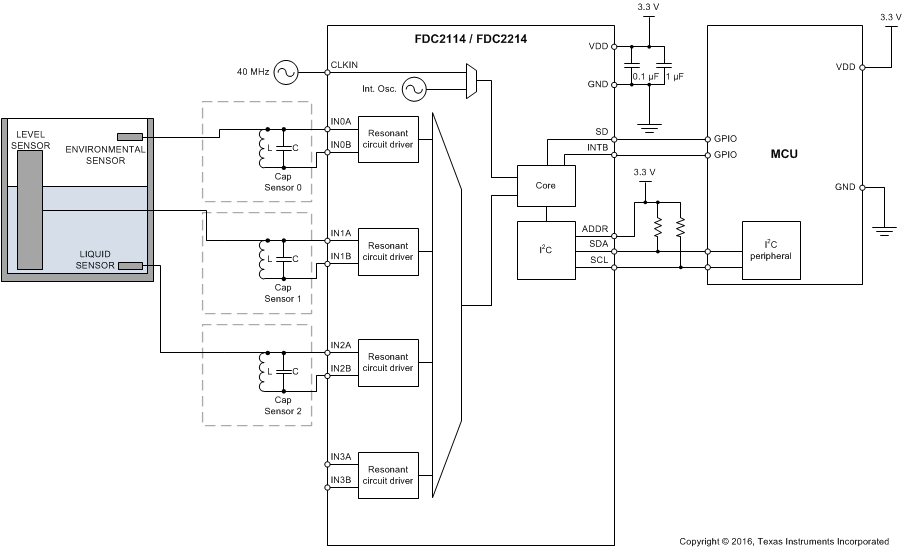ZHCSF09A May 2016 – October 2024 FDC2112-Q1 , FDC2114-Q1 , FDC2212-Q1 , FDC2214-Q1
PRODUCTION DATA
- 1
- 1 特性
- 2 应用
- 3 说明
- 4 Pin Configuration and Functions
- 5 Specifications
-
6 Detailed Description
- 6.1 Overview
- 6.2 Functional Block Diagrams
- 6.3 Feature Description
- 6.4 Device Functional Modes
- 6.5 Programming
- 6.6
Register Maps
- 6.6.1 Register List
- 6.6.2 Address 0x00, DATA_CH0
- 6.6.3 Address 0x01, DATA_LSB_CH0 (FDC2212 / FDC2214 only)
- 6.6.4 Address 0x02, DATA_CH1
- 6.6.5 Address 0x03, DATA_LSB_CH1 (FDC2212 / FDC2214 only)
- 6.6.6 Address 0x04, DATA_CH2 (FDC2114, FDC2214 only)
- 6.6.7 Address 0x05, DATA_LSB_CH2 (FDC2214 only)
- 6.6.8 Address 0x06, DATA_CH3 (FDC2114, FDC2214 only)
- 6.6.9 Address 0x07, DATA_LSB_CH3 (FDC2214 only)
- 6.6.10 Address 0x08, RCOUNT_CH0
- 6.6.11 Address 0x09, RCOUNT_CH1
- 6.6.12 Address 0x0A, RCOUNT_CH2 (FDC2114, FDC2214 only)
- 6.6.13 Address 0x0B, RCOUNT_CH3 (FDC2114, FDC2214 only)
- 6.6.14 Address 0x0C, OFFSET_CH0 (FDC21112 / FDC2114 only)
- 6.6.15 Address 0x0D, OFFSET_CH1 (FDC21112 / FDC2114 only)
- 6.6.16 Address 0x0E, OFFSET_CH2 (FDC2114 only)
- 6.6.17 Address 0x0F, OFFSET_CH3 (FDC2114 only)
- 6.6.18 Address 0x10, SETTLECOUNT_CH0
- 6.6.19 Address 0x11, SETTLECOUNT_CH1
- 6.6.20 Address 0x12, SETTLECOUNT_CH2 (FDC2114, FDC2214 only)
- 6.6.21 Address 0x13, SETTLECOUNT_CH3 (FDC2114, FDC2214 only)
- 6.6.22 Address 0x14, CLOCK_DIVIDERS_CH0
- 6.6.23 Address 0x15, CLOCK_DIVIDERS_CH1
- 6.6.24 Address 0x16, CLOCK_DIVIDERS_CH2 (FDC2114, FDC2214 only)
- 6.6.25 Address 0x17, CLOCK_DIVIDERS_CH3 (FDC2114, FDC2214 only)
- 6.6.26 Address 0x18, STATUS
- 6.6.27 Address 0x19, ERROR_CONFIG
- 6.6.28 Address 0x1A, CONFIG
- 6.6.29 Address 0x1B, MUX_CONFIG
- 6.6.30 Address 0x1C, RESET_DEV
- 6.6.31 Address 0x1E, DRIVE_CURRENT_CH0
- 6.6.32 Address 0x1F, DRIVE_CURRENT_CH1
- 6.6.33 Address 0x20, DRIVE_CURRENT_CH2 (FDC2114 / FDC2214 only)
- 6.6.34 Address 0x21, DRIVE_CURRENT_CH3 (FDC2114 / FDC2214 only)
- 6.6.35 Address 0x7E, MANUFACTURER_ID
- 6.6.36 Address 0x7F, DEVICE_ID
- 7 Application and Implementation
- 8 Device and Documentation Support
- 9 Revision History
- 10Mechanical, Packaging, and Orderable Information
7.2 Typical Application
The FDC can be used to measure liquid level in non-conductive containers. Due to very high excitation rate capability, the FDC is able to measure soapy water, ink, soap, and other conductive liquids. Capacitive sensors can be attached to the outside of the container or be located remotely from the container, allowing for contactless measurements.
The working principle is based on a ratiometric measurement; Figure 7-7 shows a possible system implementation which uses three electrodes. The level electrode provides a capacitance value proportional to the liquid level. The reference environmental electrode and the reference liquid electrode are used as references. The reference liquid electrode accounts for the liquid dielectric constant and its variation, while the reference environmental electrode is used to compensate for any other environmental variations that are not due to the liquid itself. Note that the reference environmental electrode and the reference liquid electrode are the same physical size (hREF).
For this application, single-ended measurements on the active channels are appropriate, as the tank is grounded. Use Equation 7 to determine the liquid level from the measured capacitances:

where
- CRE is the capacitance of the reference environmental electrode,
- CRL is the capacitance of the reference liquid electrode,
- CLev is the current value of the capacitance measured at the level electrode sensor,
- CLev(0) is the capacitance of the Level electrode when the container is empty, and
- hREF is the height in the desired units of the container or liquid reference electrodes.
The ratio between the capacitance of the level and the reference electrodes allows simple calculation of the liquid level inside the container itself. Very high sensitivity values (that is, many LSB/mm) can be obtained due to the high resolution of the FDC2x1x, even when the sensors are located remotely from the container. Note that this approach assumes that the container has a uniform cross section from top to bottom, so that each incremental increase or decrease in the liquid represents a change in volume that is directly related to the height of the liquid.
 Figure 7-7 FDC (Liquid Level Measurement)
Figure 7-7 FDC (Liquid Level Measurement)